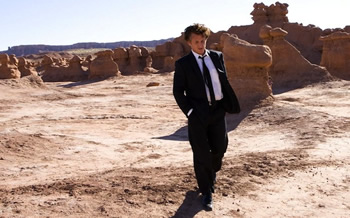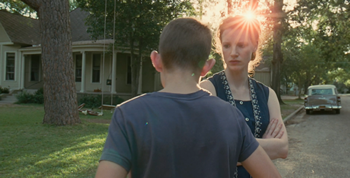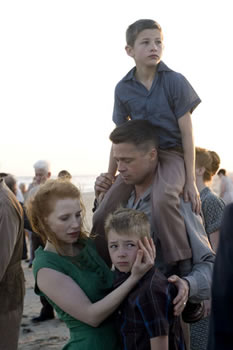Questions Not Answered: "Follow Me"
For Sunday September 25, 2011
Lectionary Readings (Revised Common Lectionary, Year A)
Exodus 17:1–7 or Ezekiel 18:1–4, 25–32
Psalm 78:1–4, 12–16 or Psalm 25:1–9
Philippians 2:1–13
Matthew 21:23–32
Some aspects of Jesus resemble the crazy uncle syndrome. Your crazy uncle is family. He's a nice guy. But just being in the same room with him makes you justifiably nervous. What will he say or do next? He's unpredictable. What taboo will he transgress? What faux pas will he commit? Doesn't he know that he makes people feel uncomfortable?
Some scholars say that if we could get behind the post-Easter "Christ of faith" and discover the authentic pre-Easter "Jesus of history," that he'd make more sense to us. No, I agree with the historian Garry Wills, that if we knew more about the historical Jesus, he'd seem more rather than less mysterious. The more difficult or unusual a gospel reading is, the more likely it's authentic and original, and that problematic aspects haven't been simplified, harmonised, or sanitized by later well-meaning copyists.
 |
Sean Penn in Malick's Tree of Life. |
We're all tempted to straightjacket the crazy uncle Jesus. To fashion him in our own image and after our own likeness. Thomas Jefferson's scissored-down Jesus is a mild-mannered moralizer guaranteed not to offend Enlightenment rationalism. Warner Sallman's portrait of Jesus with flowing blond hair and saccharine blue eyes (1940) looks like he wouldn't hurt a flea. It's disconcerting to read books like Stephen Prothero's American Jesus (2003) or Richard Fox's Jesus in America (2004) and discover our many malleable Jesuses who only faintly resemble the genuine article.
The gospel this week is a case in point. Trouble begins with the "cleansing" of the temple, a delicate euphemism for the only violent act of Jesus. The story occurs in all four gospels. Matthew, Mark and Luke place the story at the end of Jesus's ministry, after his triumphal entry and before the parable of the tenants. John places the story at the very beginning of his gospel. It's an unnerving story that reminds us that there's no "business as usual" with Jesus, and that all who come to him must do so on his terms.
When Jesus entered the temple he encountered people selling cattle, sheep and doves to the pilgrims who needed them to make their obligatory sacrifices. They also needed to exchange their Roman currency into Jewish money in order to pay the temple tax in the coinage of the "sanctuary shekel," and so he also met the money changers. A bustling nexus of commercial activity, crowds of worshippers, nationalist aspirations, political identity, historical memory, architectural splendor, and of religious affiliation, the temple constituted the essence of Jewish faith in both literal and symbolic ways.
At some point, all hell broke loose. Incensed at the sacrilege of it all, Jesus improvised a whip, thrashed the animals from the temple, scattered the coffers of the money changers, and overturned their tables: "How dare you turn my Father's house into a market!" Later his disciples remembered Psalm 69:9 and attached a sense of prophetic fulfillment to the event: "Zeal for your house will consume me."
 |
Malick's Tree of Life. |
It's not clear whether Jesus objected to any and all commercial activity in the temple, even honest transactions that were necessary for pilgrims to fulfill their religious obligations, or whether he excoriated the fraud, exploitation and avarice of the religious authorities who controlled the means of ritual purity.
When asked to justify his violent actions with a sign, Jesus refused; instead of any interpretation, justification or explanation, he responded with an enigmatic saying: "Destroy this temple, and I will raise it again in three days." Long after the event, his disciples interpreted Jesus's dark saying as a prediction of his death and resurrection.
Jesus joined a violent act with an enigmatic saying that has elicited several layers of interpretation. A few people see a prophetic prediction of the destruction of the temple that occurred in 70 AD. A simpler interpretation understands the story as a purification of the temple to its sacred purpose, as a place of prayer for all people, without manipulation or exploitation by the establishment gatekeepers. A third nuance suggests that in his own body Jesus fulfills all the functions of the temple building as the place to meet God.
No doubt the disciples tossed and turned a long, sleepless night that evening; it must have been terribly disconcerting to witness Jesus unhinged, throwing furniture, screaming at the top of his lungs, and flinging money into the air. Perhaps they ran for cover with the crowd. I would have. Did they look him in the eyes the next morning, or shuffle their feet, stare at the ground, and make small talk?
The cleansing of the temple is a stark warning against any and every false sense of security. Misplaced allegiances, religious presumption, pathetic excuses, smug self-satisfaction, spiritual complacency, nationalist zeal, political idolatry, and economic greed in the name of God are only some of the tables that Jesus would overturn in his own day and in ours. Church is more than a place to enjoy a night of bingo or to reinforce my prejudices and illusions.
The next day the religious leaders confronted Jesus in those same temple courts: "By what authority are you doing these things?" It's an honest question. We shouldn't be too hard on the religious bureaucrats. They were just doing their job, keeping the peace, trying to figure things out, and maintain the status quo. It's quite natural for authorities to question a boundary-breaker like Jesus.
But just like the previous day, Jesus answered their question with his own question: was John's baptism truly divine or merely human? This trapped the temple teachers. If they said it was merely human, they feared reprisals from the crowds. And if they admitted that John's baptism was from God, then they had no excuse for not accepting it and repenting. They were caught between fear and disobedience.
 |
The O'Briens in Malick's Tree of Life. |
So Jesus didn't answer their question: "Neither will I tell you by what authority I do these things."
And neither does Jesus answer our own questions today, many of which are honest questions. Why can't I get a job after two years of unemployment? Why do millions die by starvation in Somalia? What is prayer?
Instead of answering questions, Jesus tells a story. A lazy son refused to work but then changed his mind and obeyed his father's request. His brother did the opposite: he promised to work but then didn't. Jesus compared the temple authorities to the latter son. They made bold claims but did little. Tax collectors and prostitutes, said Jesus, would enter the kingdom of God before them, for they promised nothing but nevertheless believed John's message of invitation and indictment.
Terrence Malick's new film The Tree of Life depicts our human struggle to squeeze meaning out of life in a cosmos that is beautiful, terrifying, and therefore full of honest questions. A recurring flame in the movie symbolizes what A.O. Scott of the New York Times calls an "elusive deity" who is "both the film’s overt subject and the source of its deepest, most anxious mysteries." To explore these questions, Malick focuses on one family in Waco, Texas (where Malick was born) during the 1950s.
The O'Briens are a young couple with three boys who experience the gift of life with all its joys and sorrows. The father is deeply devoted to his family, but understandably scary to his children. He's known vocational disappointment, financial reversal, deep regrets, and feelings of failure. The mother observes that we all have a choice to live "by nature or by grace." To live by grace means we'll never be disappointed, no matter how many questions go unanswered. To live by nature means we'll never know happiness, no matter how great our gain.
Like the cleansing of the temple and the questioning of Jesus' authority, The Tree of Life begins with a quotation from Job 38:4 that's a divine question instead of an answer: "Where were you when I laid the foundations of the earth? Tell me, if you understand." The film ends with a voice-over prayer : "Help us. Guide us 'til the end of time." After a long pause that leaves many unanswered questions, this prayer is followed by a cosmic response: "Follow me."
Image credits: (1) The Independent Film Channel; (2) The Film Stage; and (3) Gilt Group.





